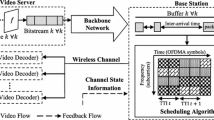Abstract
In this paper, we propose a new framework to analyze performance considering finite-length queuing and adaptive modulation and coding for multi-user Voice over IP (VoIP) services in wireless communication systems. We formulate an uplink VoIP system as a two-dimensional discrete-time Markov chain (DTMC) based on a Markov modulated Poisson process traffic model for VoIP services and modulation and coding scheme (MCS)-level set transition reflecting users’ channel variations. We extend the transition modeling of the MCS-level for a single-user to the transition modeling of the MCS-level set for multiple users. Since the users can have various MCS combinations in the case of a multi-user system, the MCS-level set transitions are more complicated than the MCS-level transitions of the single-user case. Throughout our DTMC formulation, we present various performance metrics, such as average queue-length, average throughput, packet dropping probability, packet loss probability, and so on. By using the results of the packet loss probability, we can find an optimum packet error rate value that minimizes the total packet loss probability.









Similar content being viewed by others
Notes
The IEEE 802.16e/m system denotes a bandwidth request process for data transmission as a polling process.
References
Doufexi, A., Armour, S., Butler, M., Nix, A., Bull, D., McGeehan, J., & Karlsson, P. (2002). A comparison of the HIPERLAN/2 and IEEE 802.11a wireless LAN standards. IEEE Communications Magazine 40(5), 172–180.
Kwon, T., Lee, H., Choi, S., Kim, J., Cho, D.-H., Cho, S., Park, W.-H., Yun, S., & Kim, K.-H. (2005). Design and implementation of simulator based on cross-layer protocol between MAC and PHY layers in WiBro compatible 802.16e OFDMA systems. IEEE Communications Magazine 43(12), 136–146.
McBeath, S., Smith, J., Chen, L., & Soong, A. C. K. (2008). VoIP support using group resource allocation based on the UMB system. IEEE Communications Magazine 46(1), 114–120.
Catreux, S., Erceg, V., Gesbert, D., & Heath, R. W. Jr. (2002). Adaptive modulation and MIMO coding for broadband wireless data networks. IEEE Communications Magazine 40(6), 108–115.
Goldsmith, A. J., & Chua, S.-G. (1998). Adaptive coded modulation for fading channels. IEEE Transactions on Communications 46(5), 595–602.
Heffes, H., & Lucantoni, D. M. (1986). A Markov modulated characterization of packetized voice and data traffic and related statistical multiplexer performance. IEEE Journal on Selected Areas of Communications 4(6), 856–868.
Baiocchi, A., Melazzi, N. B., Listanti, M., Roveri, A., & Winkler, R. (1991). Loss performance analysis of an ATM multiplexer loaded with high-speed ON-OFF sources. IEEE Journal on Selected Areas of Communications 9(3), 388–393.
So, J.-W. (2008). Performance analysis of VoIP services in the IEEE 802.16e OFDMA system with inband signaling. IEEE Transactions on Vehicular Technology 57(3), 1876–1886.
Niyato, D., & Hossain, E. (2005). Queue-aware uplink bandwidth allocation for polling services in 802.16 broadband wireless networks. Proceedings on IEEE Globecom 6, 2702–3706.
Liu, Q., Zhou, S., & Giannakis, G. B. (2005). Queuing with adaptive modulation and coding over wireless links: Cross-layer analysis and design. IEEE Transactions on Wireless Communications 4(3), 1142–1153.
Wang, X., Liu, Q., & Giannakis, G. B. (2007). Analyzing and optimizing adaptive modulation coding jointly with ARQ for QoS-guaranteed traffic. IEEE Transactions on Vehicular Technology 56(2), 710–720.
Brady, P. T. (1969). A model for generating ON-OFF speech patterns in two-way conversations. Bell System Technology Journal 48(7), 2445–2472.
Shah-Heydari, S., & Le-Ngoc, T. (1998). MMPP modeling of aggregated ATM traffic. Proceedings on IEEE Canadian Conference on Electrical and Computer Engineering 1, 129–132.
Huang, J., Le-Ngoc, T., & Hayes, J. F. (1996). Broadband SATCOM system for multimedia services. Proceedings on IEEE ICC 2, 906–909.
Kim, S.-B., Lee, M.-Y., & Kim, M.-J. (1994). ∑-matching technique for MMPP modeling of heterogeneous ON-OFF sources. Proceedings IEEE Globecom 2, 1090–1094.
Razavilar, J., Liu, K. J. R., & Marcus, S. I. (2002). Jointly optimized bit-rate/delay control policy for wireless packet networks with fading channels. IEEE Transactions on Communications 50(3), 484–494.
Wang, H. S., & Moayeri, N. (1995). Finite-state Markov channel—A useful model for radio communication channels. IEEE Transactions on Vehicular Technology 44(1), 163–171.
Yacoub, M. D., Vargas Bautista, J. E., & de Guedes, L. G. R. (1999). On higher order statistics of the Nakagami-m distribution. IEEE Transactions on Vehicular Technology 48(3), 790–794.
Stüber, G. L. (2001). Principles of mobile communication (2nd ed.). Norwell, MA: Kluwer.
Liu, Q., Zhou, S., & Giannakis, G. B. (2004). Cross-layer combining of adaptive modulation and coding with truncated ARQ over wireless links. IEEE Transactions on Wireless Communications 3(5), 1746–1755.
Alouini, M.-S., & Goldsmith, A. J. (2000). Adaptive modulation over Nakagami fading channels. Wireless Personal Communications: An International Journal 13(1–2), 119–143.
IEEE 802.16e-2005. (2006). IEEE standard for local and metropolitan area networks—part 16: Air interface for fixed and mobile broadband wireless access systems—amendment 2: Physical and medium access control layers for combined fixed and mobile operation in licensed bands and corrigendum 1. Feb 28 2006.
Lee, H., Kwon, T., & Cho, D.-H. (2006). Extended-rtPS algorithm for VoIP services in IEEE 802.16 systems. IEEE International Conference on Communications 5, 2060–2065.
Acknowledgments
This research was funded by the MSIP (Ministry of Science, ICT & Future Planning), Korea in the ICT R&D Program 2013.
Author information
Authors and Affiliations
Corresponding author
Rights and permissions
About this article
Cite this article
Lee, H., Lee, S. & Cho, DH. Performance analysis of wireless multi-user VoIP system with adaptive modulation and coding. Wireless Netw 20, 747–757 (2014). https://doi.org/10.1007/s11276-013-0638-1
Published:
Issue Date:
DOI: https://doi.org/10.1007/s11276-013-0638-1




